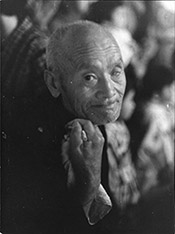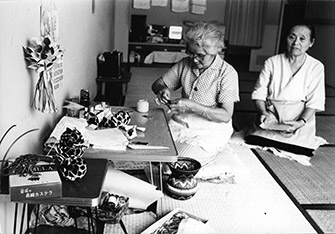Elder Orphans
Since the bombing took husbands, wives, and children along with possessions, many people were left alone after the war. As this group aged they came to be called the ‘elder orphans.’
Some lost their entire family to the A-bomb. Some families scattered after the bombing and lost contact with each other. Others ended up on their own because of changes in family structure, while some simply chose to live a solitary existence.
“Why I am still alive? It would be best to die soon.”
In the latter half of the 1960s, the elder orphans, coping with loneliness and anxiety about health and poverty, once again began losing the will to live. This phenomenon was recognized as a social problem and relief efforts were undertaken.

Summer festival
This elderly man who lost one eye and his family in the atomic bombing came to the summer festival seeking a lively place.
1954 Mikawa-cho Enryuji Temple
Photo by Yuichiro Sasaki
Courtesy of Yugo Shioura

At a care facility
A facility for the care of A-bomb survivors called Funairi Mutsumien opened in April, 1970.
1971 Funairi Mutsumien
Photo by Yuichiro Sasaki
Courtesy of Yugo Shioura
Atomic Bomb Memorial Mound
In January 1946, the Hiroshima War Victims Consolation Association was established to receive the remains of A-bomb victims temporarily buried throughout the city immediately after the bombing and to hold memorial services for them. In May of that year, a War Victim Memorial Tower was built at Jisenji-no-hana, which was joined by a crypt and a worship hall in July, thanks to donations from the people of Hiroshima. In July 1955, the present Atomic Bomb Memorial Mound was established in the northwest section of Peace Memorial Park.
As the city of Hiroshima continued its recovery, the remains of A-bomb victims found at road and housing construction sites were gathered in the Memorial Mound. Victims’ remains housed within the mound numbered into the tens of thousands.
As of August 5, 2012, the number of people whose remains have been identified but remain unclaimed reached 816.

People praying at the War Victim Memorial Tower
In May 1946, a War Victim Memorial Tower was erected at Jisenji-no-hana.
August 6, 1949
Nakajima-hon-machi (now, Nakajima-cho)
Photo by Yuichiro Sasaki
Courtesy of Yugo Shioura
